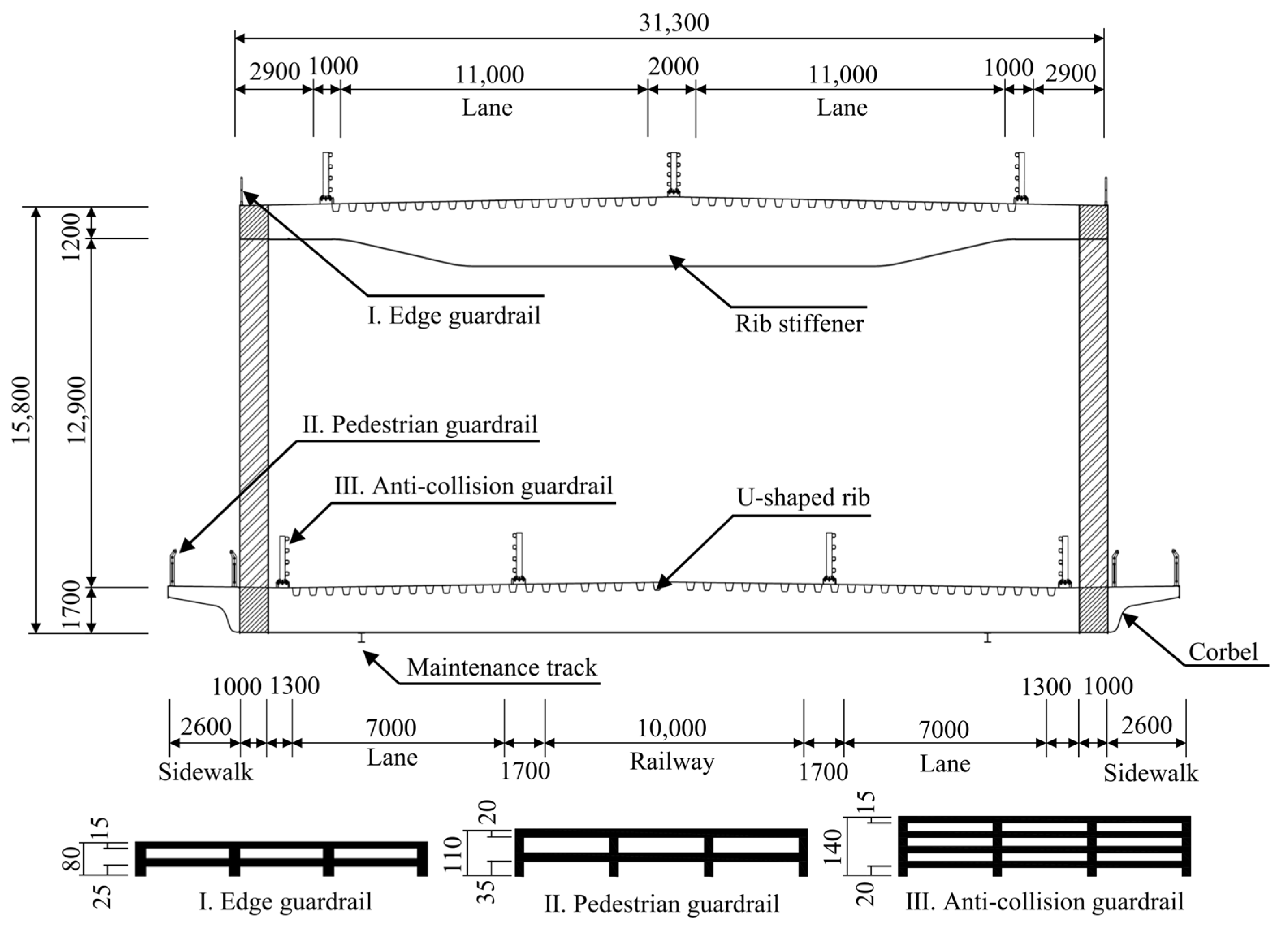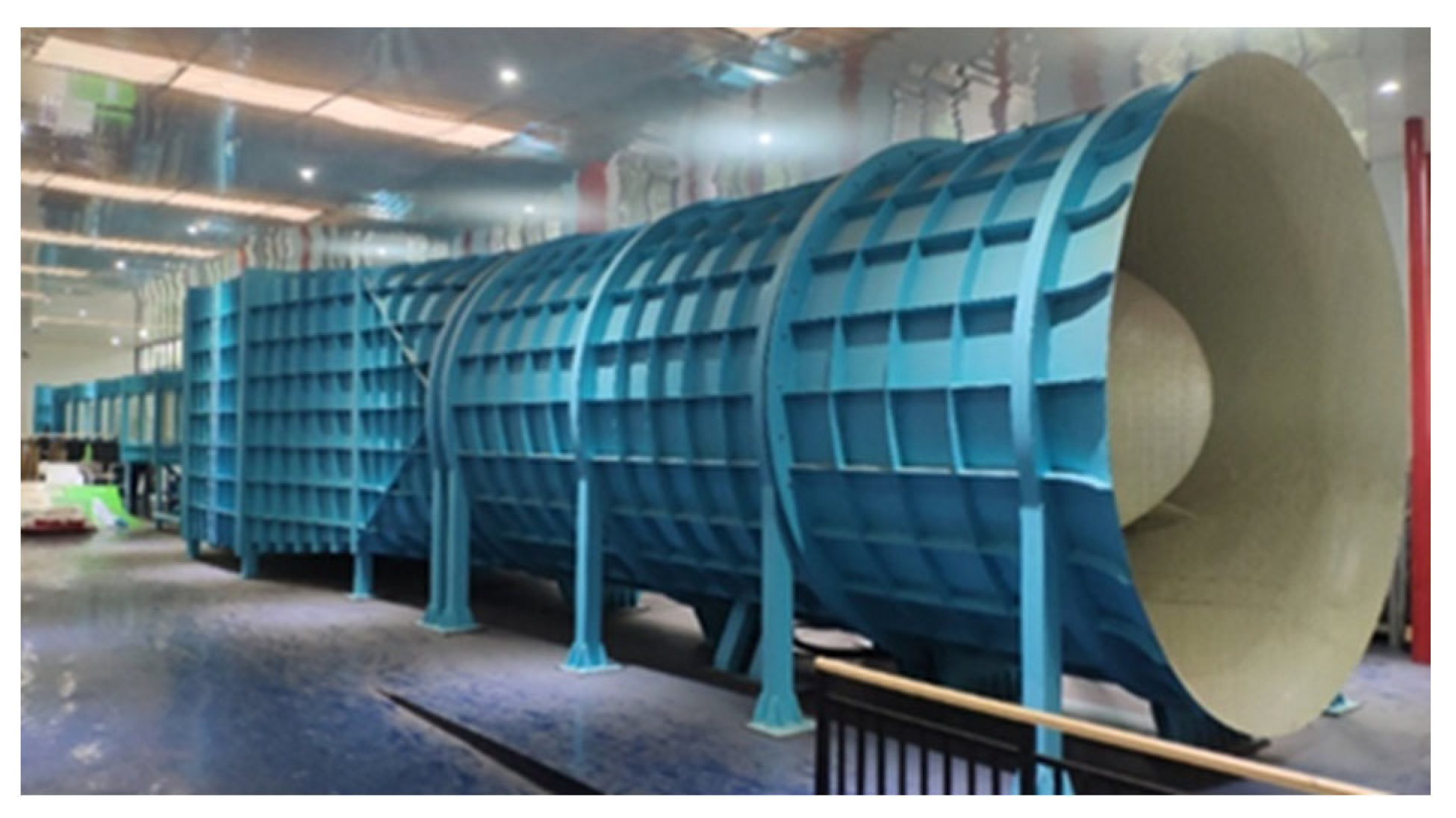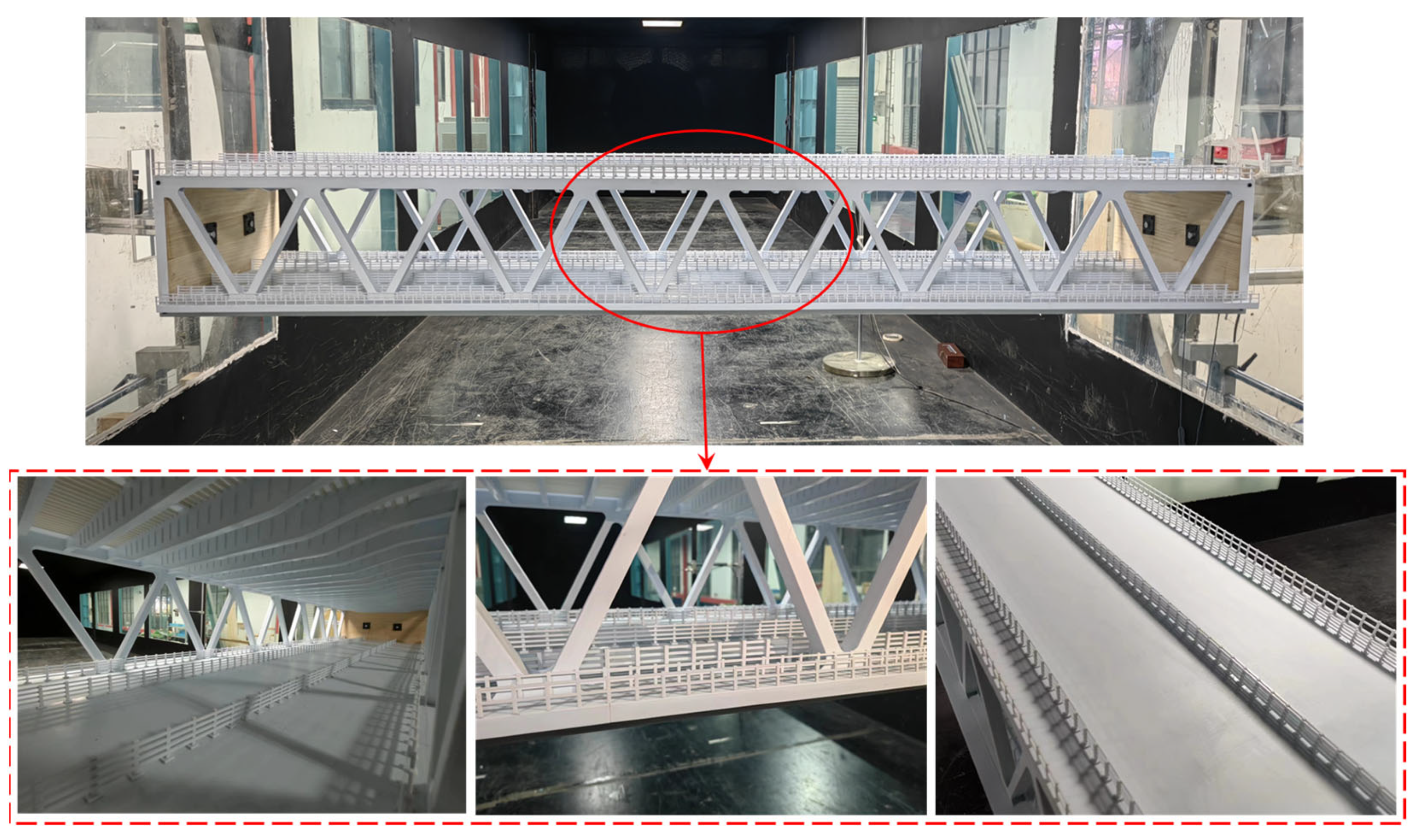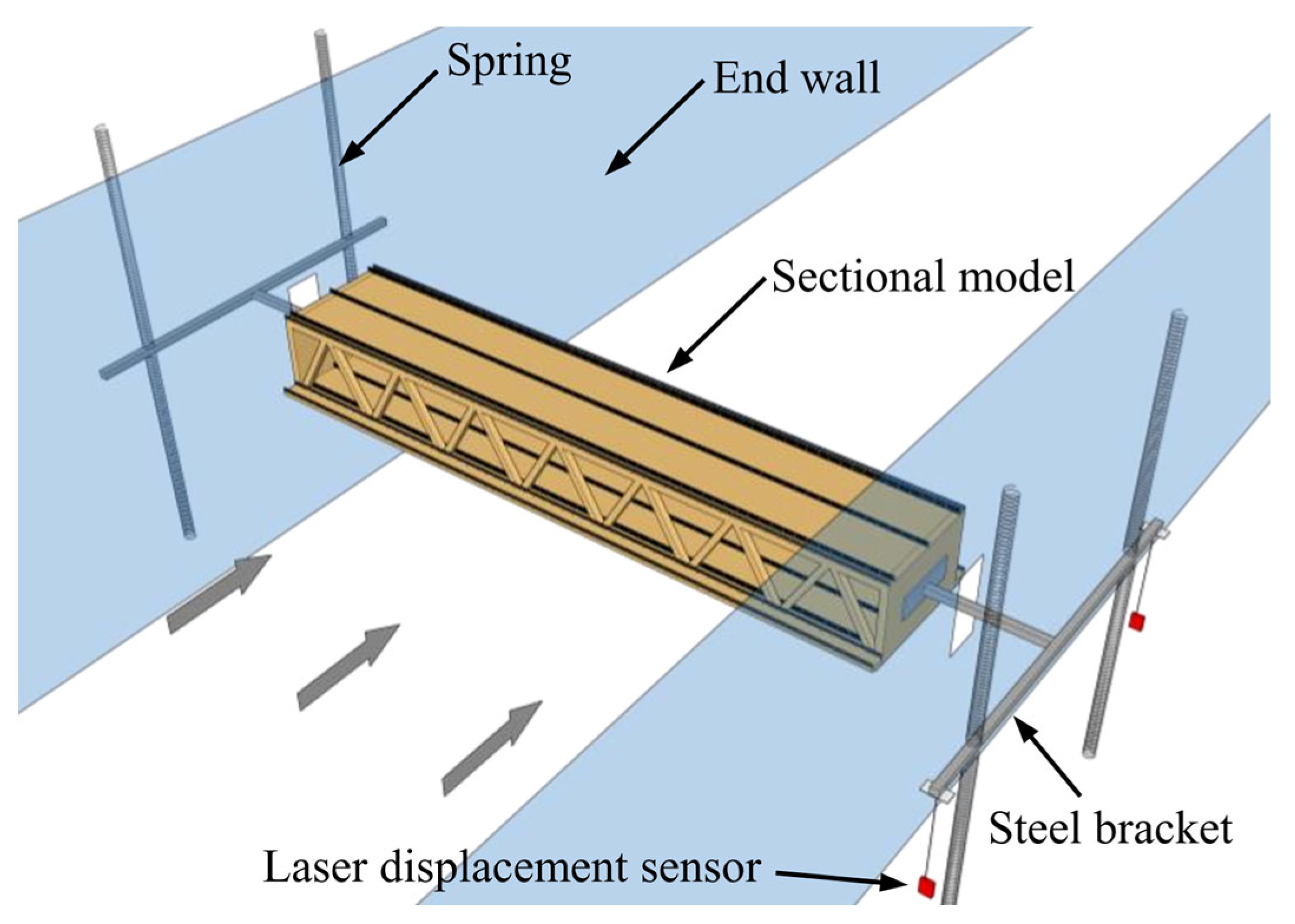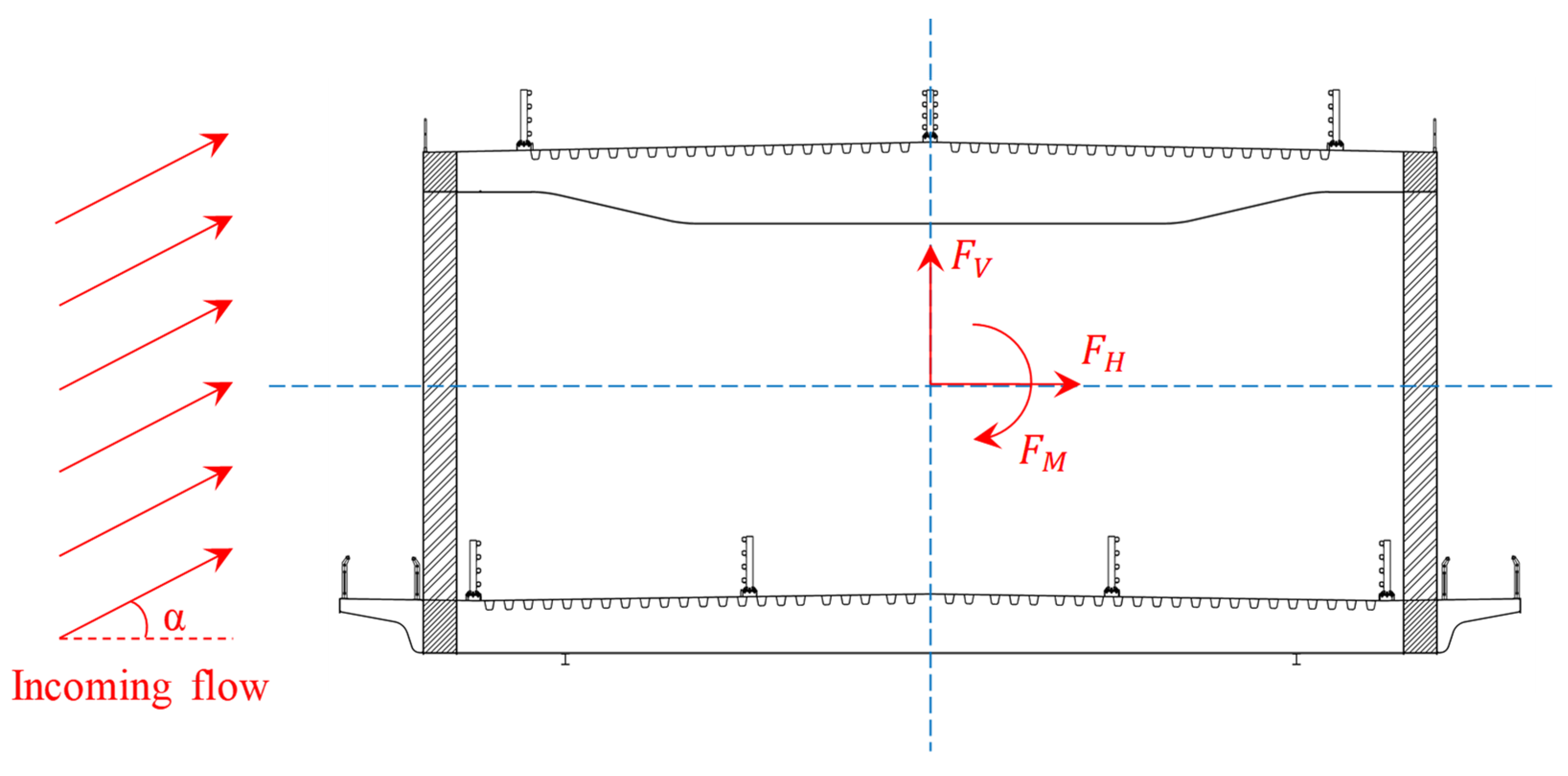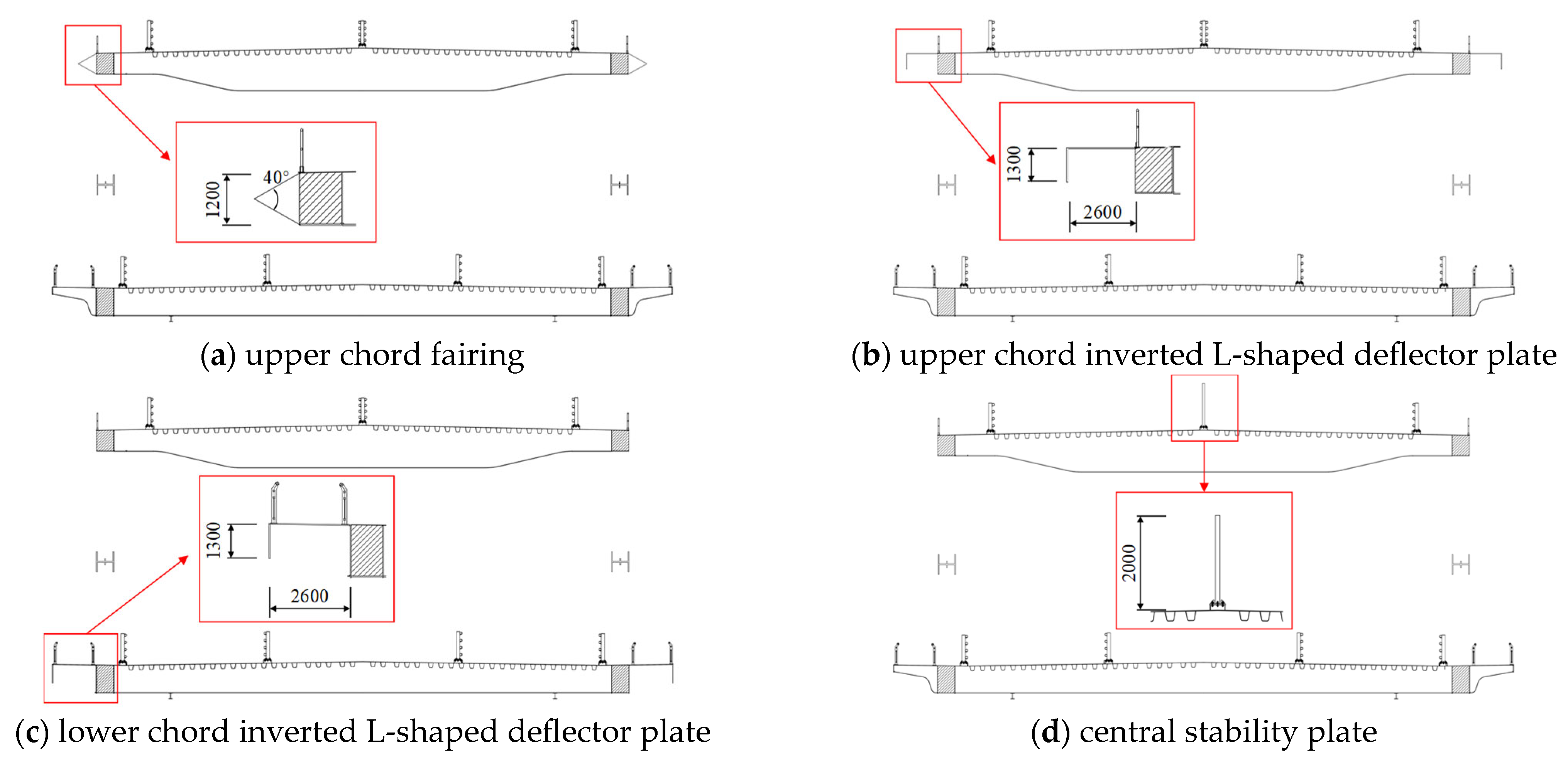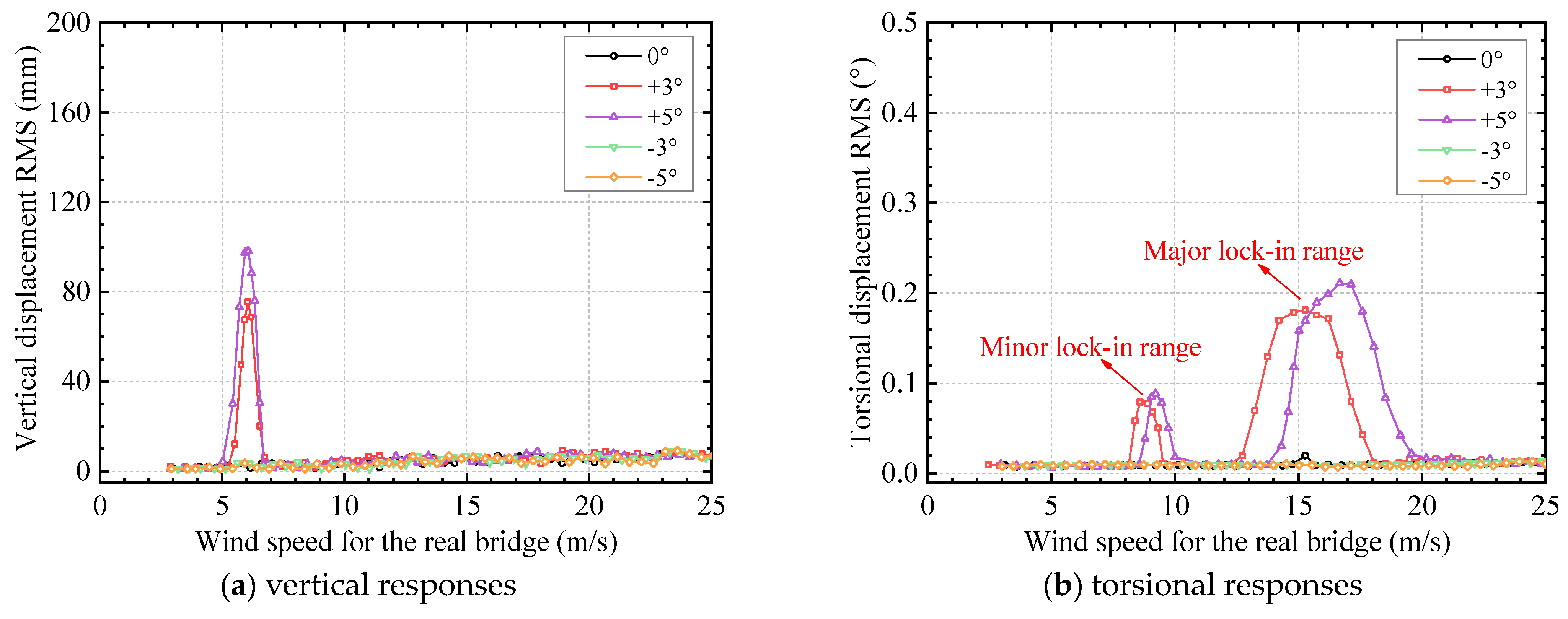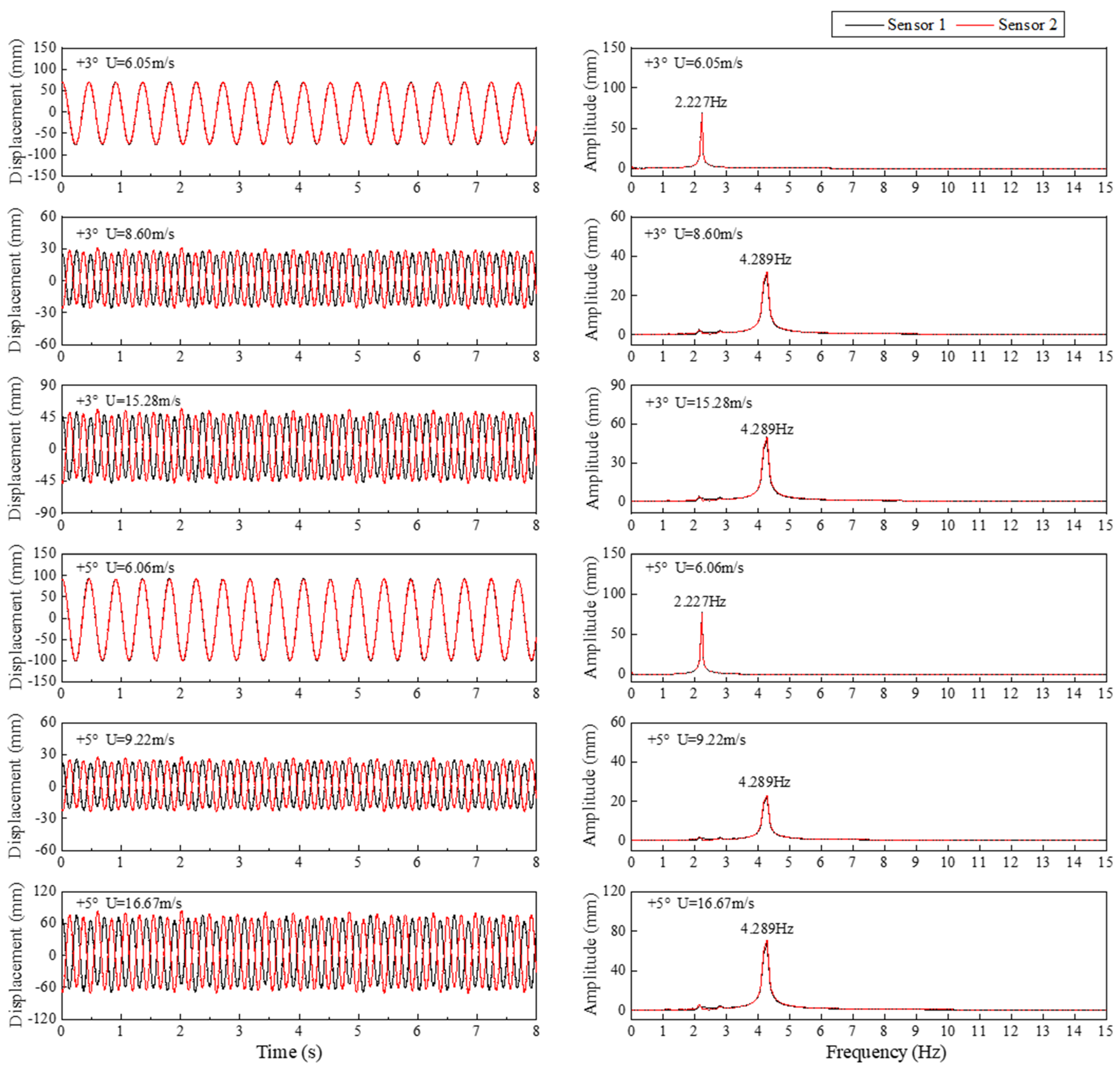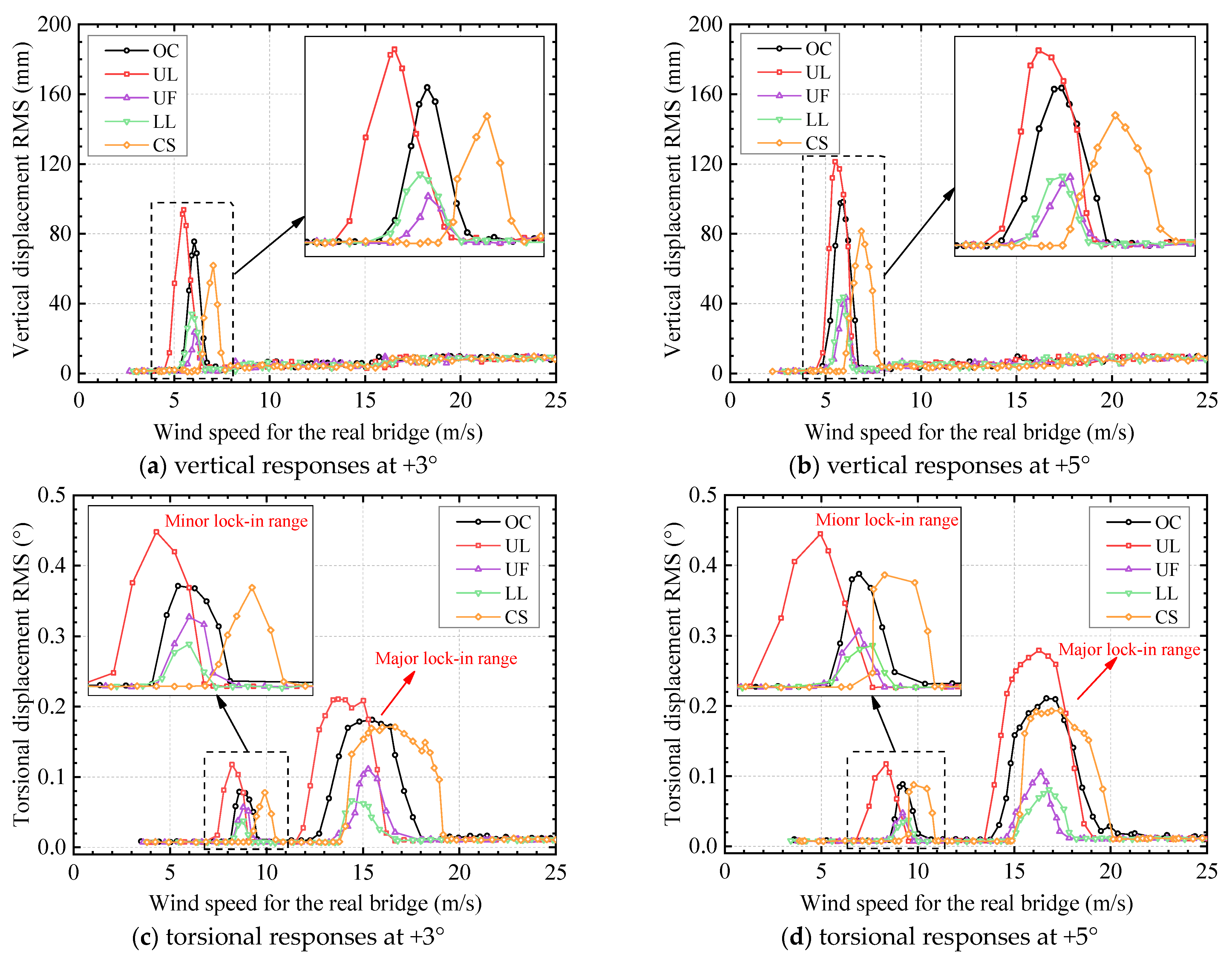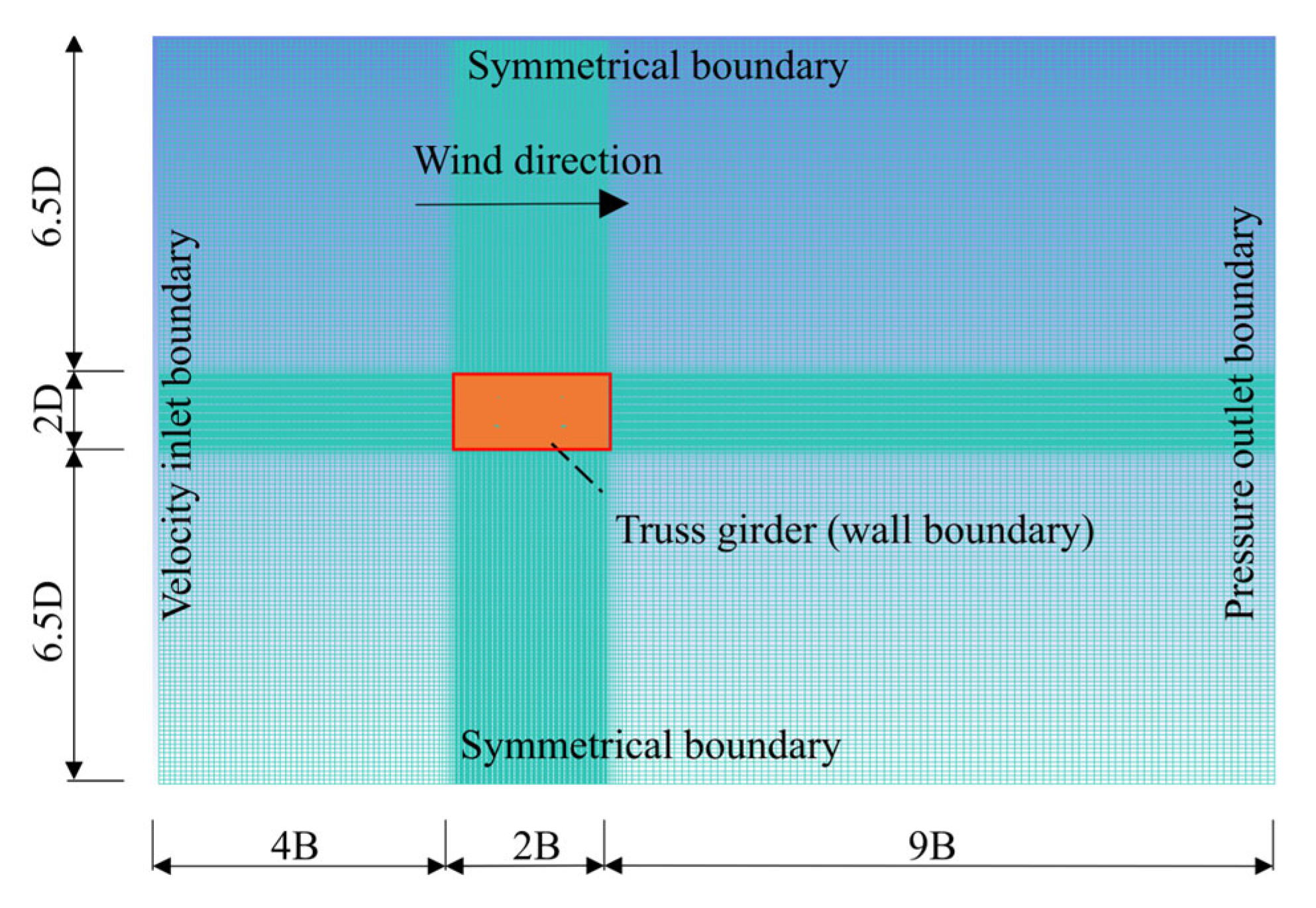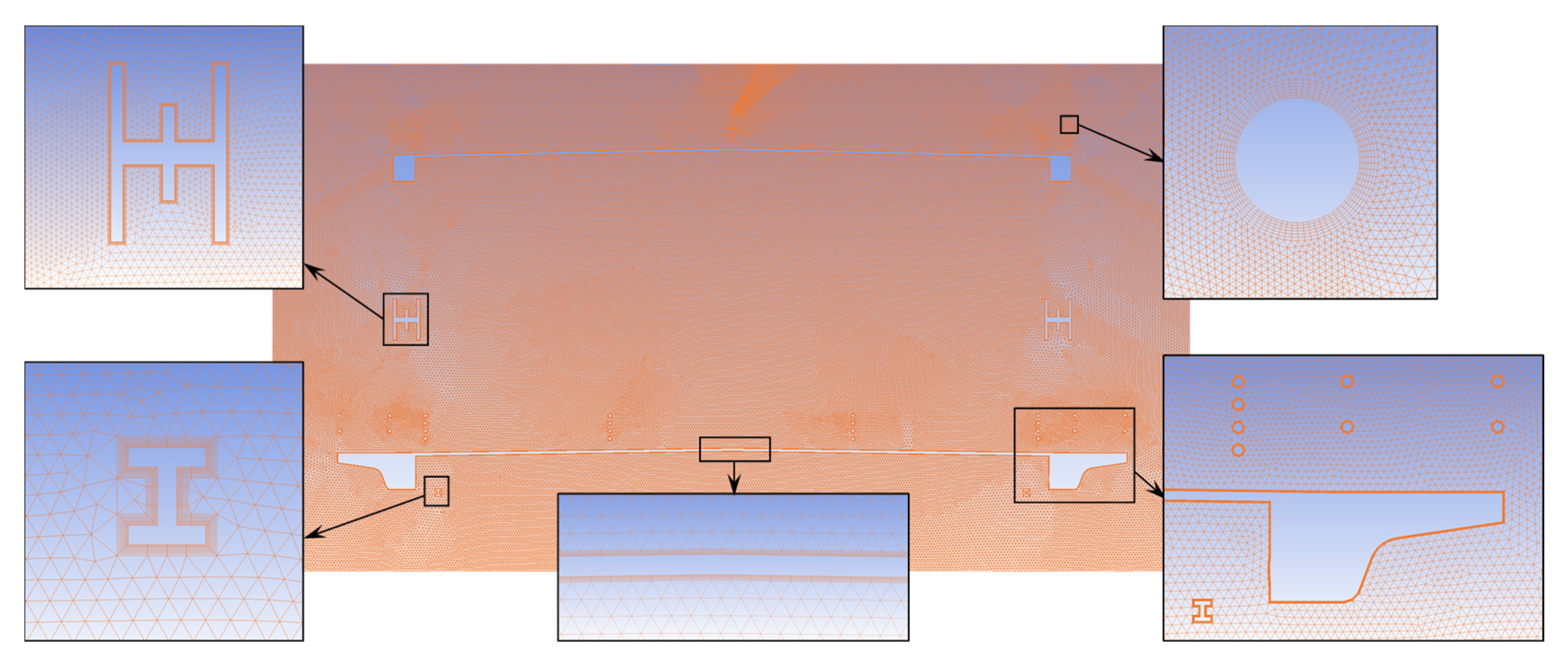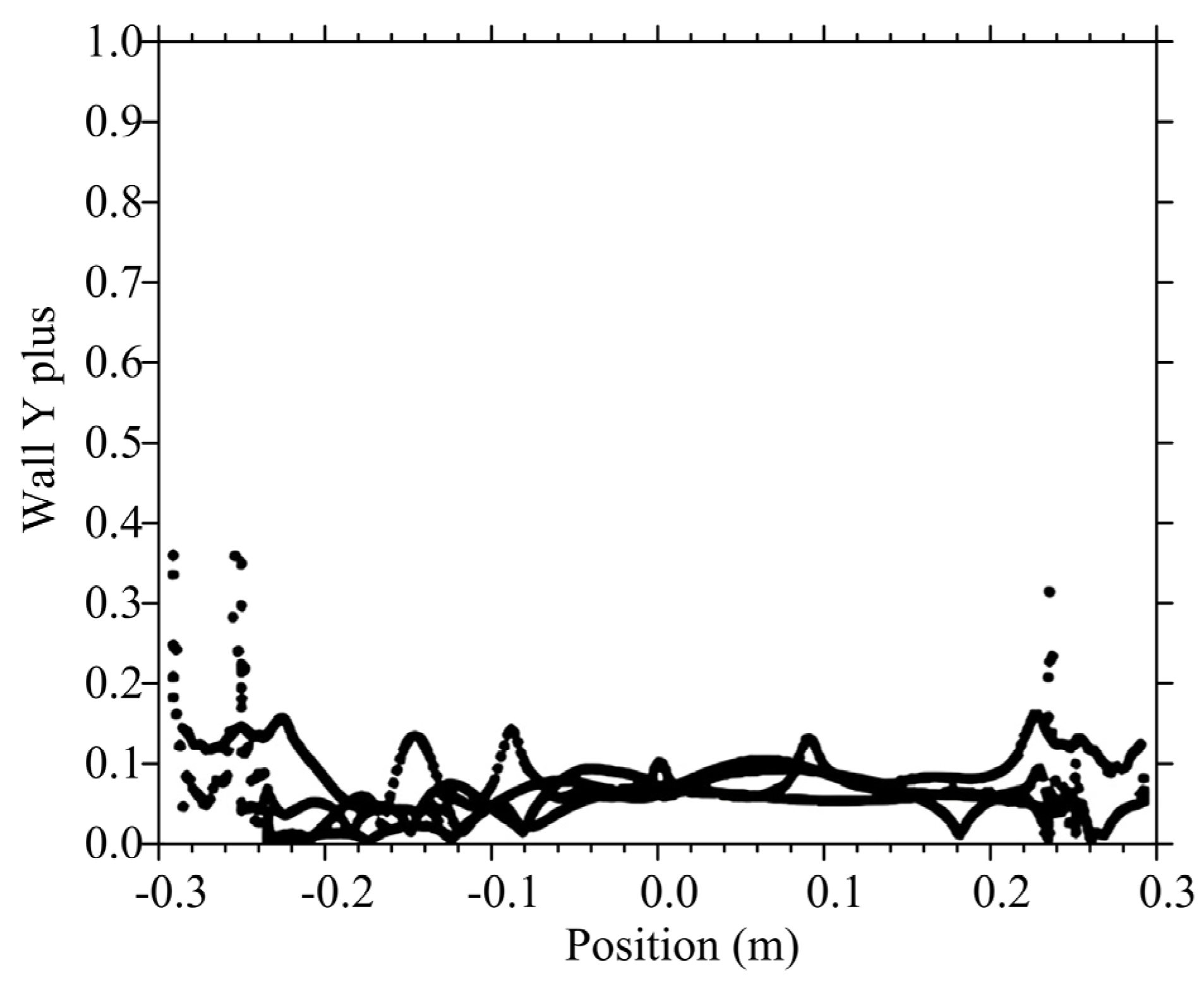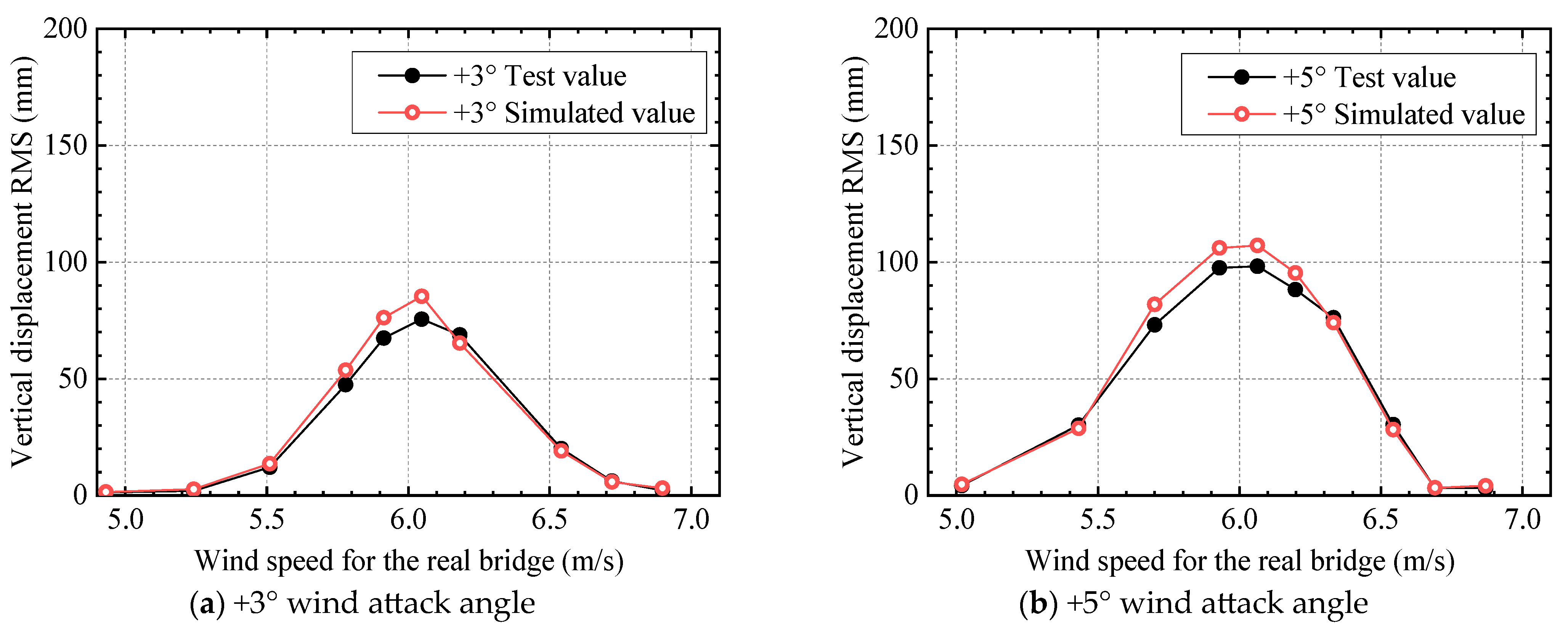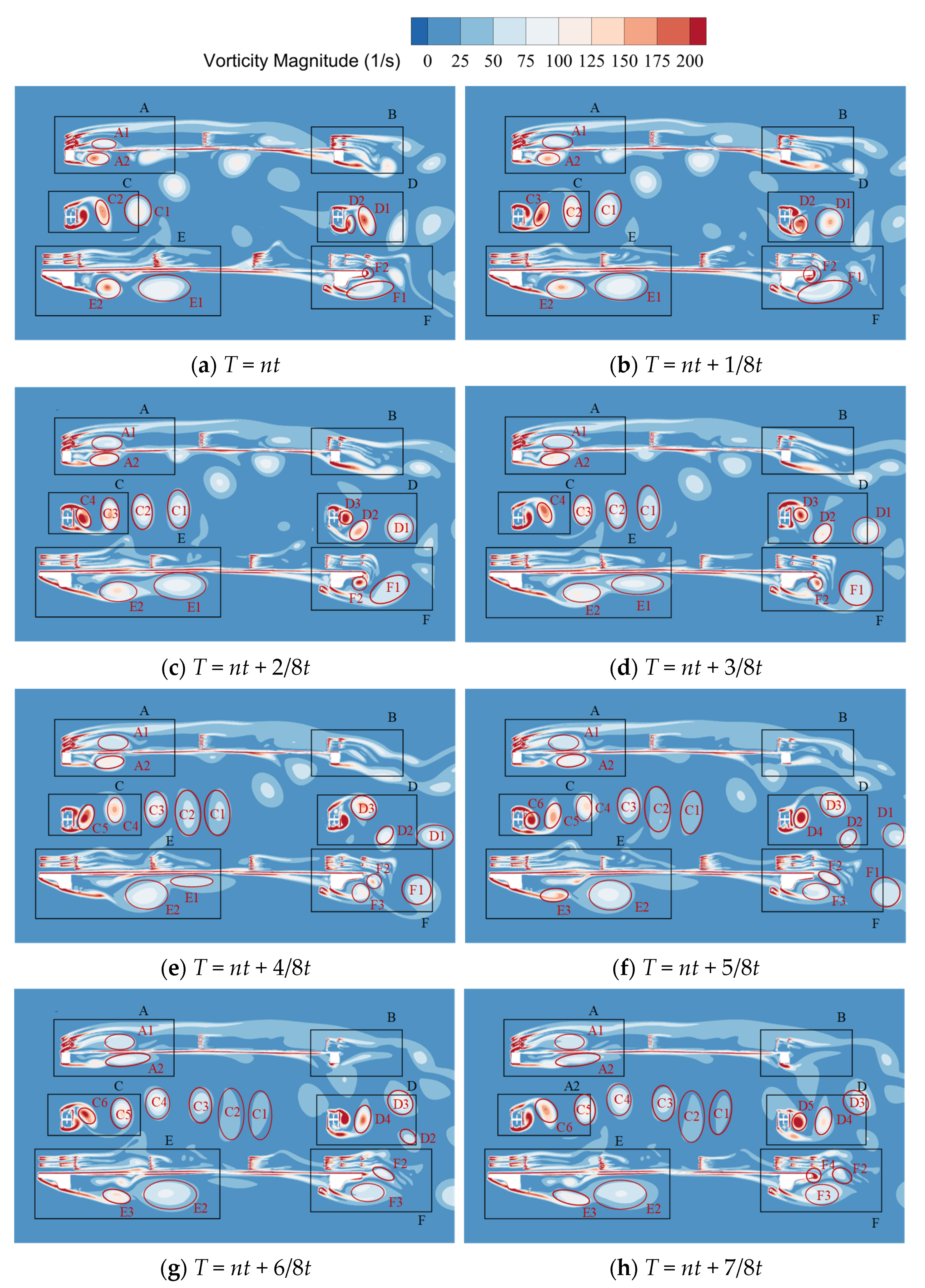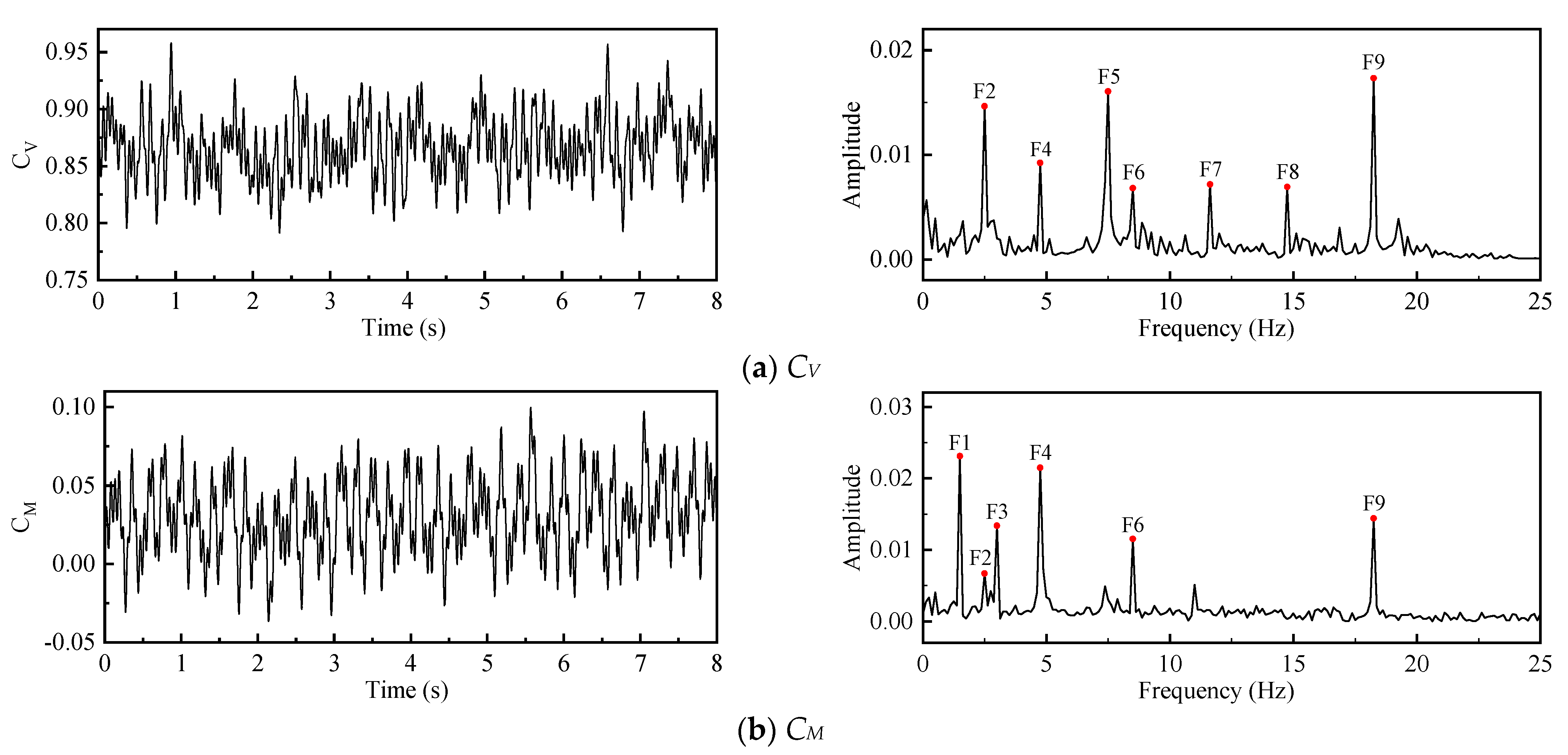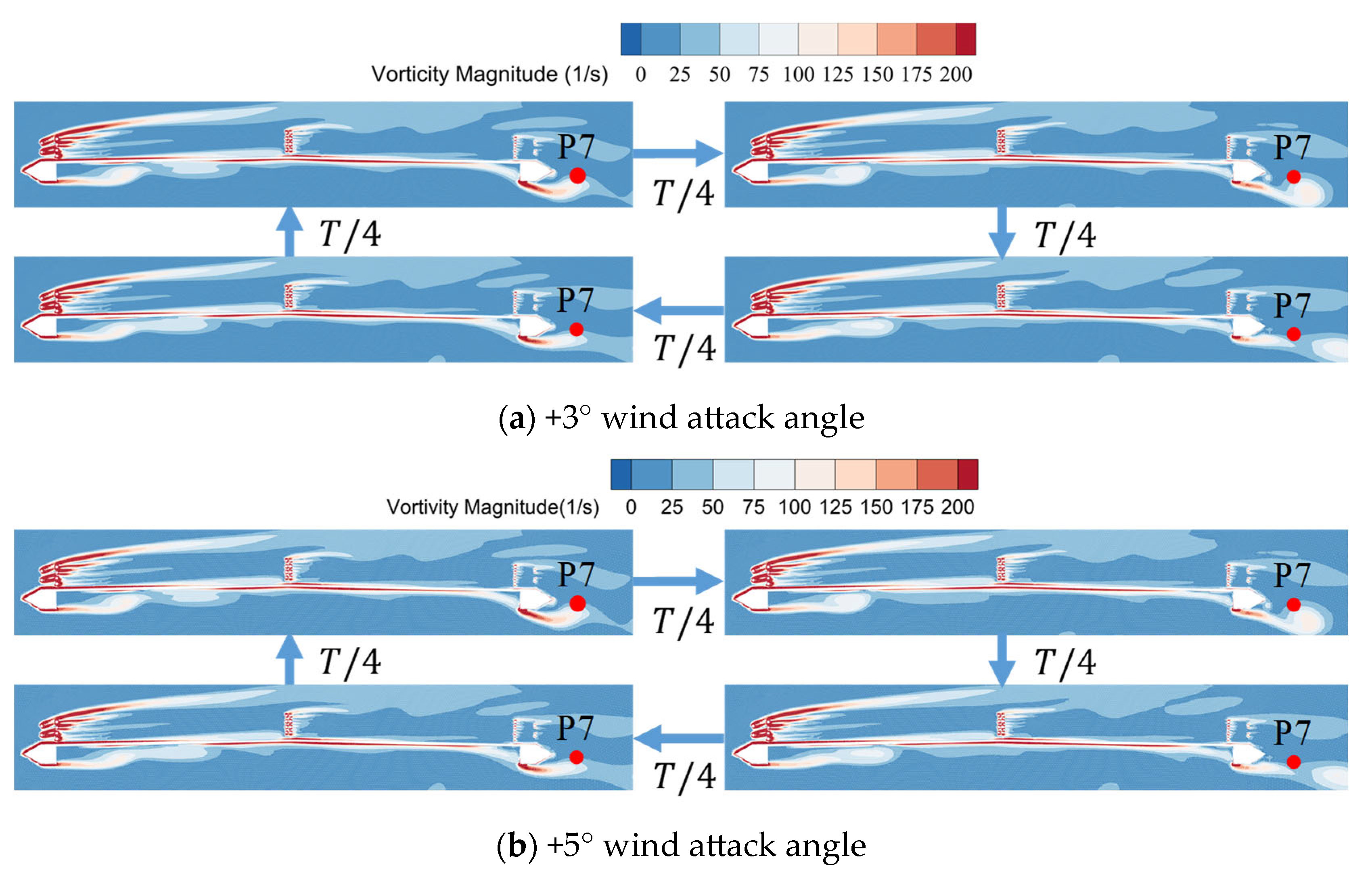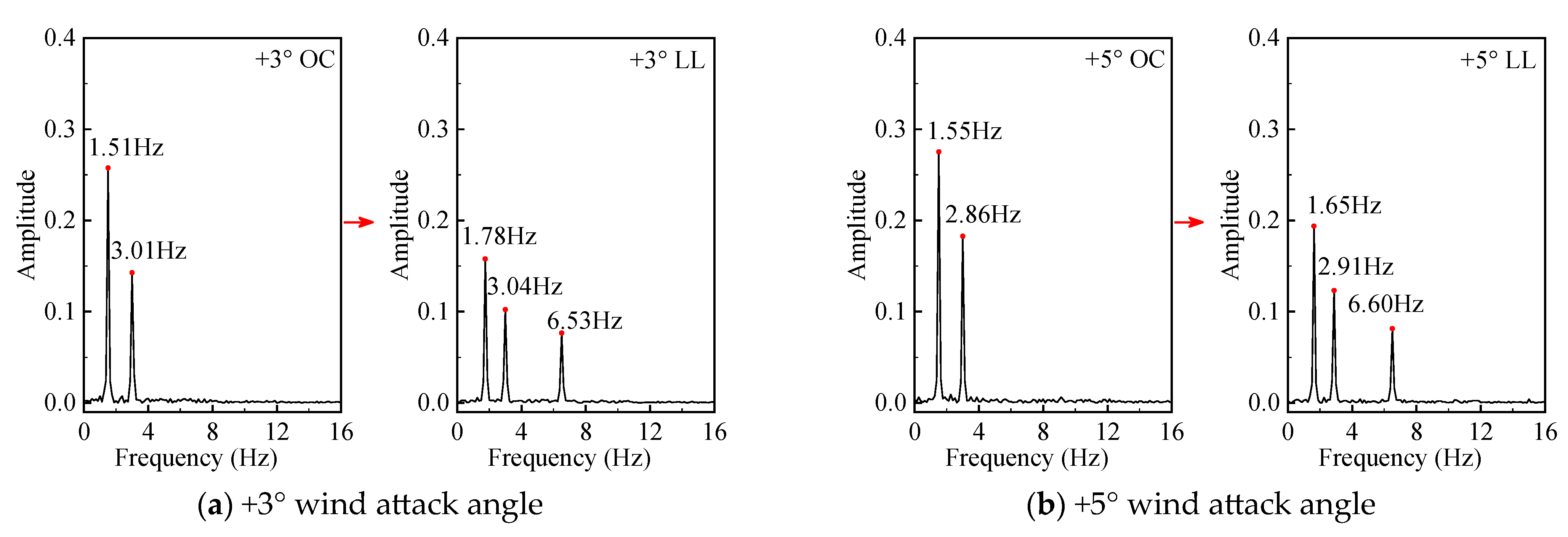1. Introduction
Suspension bridges are commonly utilized for their excellent performance in large-span cross-sea bridges [
1,
2,
3]. Rapid development in highway and rail transportation has resulted in new demands for cross-sea bridges, leading to an increase in the construction of double-deck truss girder bridges, such as the Xinhai Bay Bridge and the Beikou Bridge. Truss girders are widely used for road–rail bridges due to their high rigidity and ability to accommodate double bridge decks [
4]. However, truss girders consist of numerous discrete components. Wide bridge decks may result in multiple vortexes migrating across the direction of their width [
5,
6,
7]. Furthermore, different components exhibit varying bluff body aerodynamic characteristics, which results in the generation of multi-scale and multi-frequency vortex shedding, thereby complicating the truss girder’s vortex-induced vibration (VIV) performance. Additionally, the distance between certain components varies along the axis of the bridge, causing complicated aerodynamic disturbance. Consequently, evaluating the VIV performance of double-deck truss girders in the complex marine environment is more challenging than that of other girders and requires a more thorough investigation.
VIV has dual characteristics of self-excited and forced vibration [
8]. While VIV generally limits amplitude, it occurs frequently and for extended periods even at low wind speeds. This phenomenon may cause fatigue damage to the structure, and an excessive amplitude may also jeopardize the safety of traffic on the bridge [
9,
10,
11,
12,
13]. Several bridges, such as the Xihoumen Bridge [
14], the Rio–Niteroi Bridge [
15], the Second Severn Crossing Bridge [
16], the Humen bridge [
17], the Great Belt Bridge [
18], and the Trans-Tokyo Bay Crossing Bridge [
19], have experienced significant VIV during their use. Therefore, it is essential to analyze VIV and implement vibration mitigation measures for long-span truss girder suspension bridges [
20,
21].
Currently, there are four primary research methods for investigating VIV in suspension bridges: theoretical analysis [
22], field measurements [
23], wind tunnel tests [
24], and numerical simulations [
25]. Wind tunnel tests and numerical simulations are the most commonly employed methods. Wind tunnel tests are widely used to simulate the fluid–structure coupling phenomenon of VIV via replicating the wind characteristics and structural dynamic behavior of the atmospheric boundary layer. The dynamic response of sectional models is measured using displacement sensors, accelerometers, and novel optical testing techniques such as digital image correlation (DIC) and three-dimensional laser Doppler velocimetry (3DLDV) [
26]. With the advancement of computer technology, numerical simulations can accurately obtain the dynamic characteristics, aerodynamic forces, and flow field properties of bridge structures, making significant contributions to the study of VIV mechanisms. In wind tunnel tests, particle image velocimetry (PIV) can be utilized to obtain the flow field characteristics around the girder, which can serve as a useful cross-check for simulation results [
27].
Vibration suppression measures that are commonly used include aerodynamic, mechanical, and structural measures [
28,
29,
30,
31,
32]. Aerodynamic mitigation measures promote the aerodynamic performance of a girder by altering its shape [
33]. Due to their economic, aesthetic, safety, and high reliability advantages, they are widely used in bridge wind engineering [
34,
35,
36,
37]. Currently, two methods are used to suppress VIV through aerodynamic measures. The first is to optimize the girder’s original cross-section shape by modifying the guardrail ventilation rate and maintenance track position, etc. The second is to install aerodynamic mitigation measures such as inverted L-shaped deflector plates, fairings, stability plates, and spoiler plates, etc. Although various aerodynamic mitigation schemes exist, more accurate and universally applicable application rules are needed. In practical engineering applications, it is necessary to verify their effectiveness through wind tunnel tests.
Research on the VIV of bridges has mainly focused on box girders and Π-shaped girders. Zhan et al. [
38] discovered that the wave barrier has a three-dimensional disturbance effect on the box girder’s wake, which can be used to suppress its VIV. Nagao et al. [
39] found that shape factors, such as the position and size of guardrails, significantly influence the sectional VIV performance. Bai et al. [
40] investigated the impact of aerodynamic mitigation measures, such as installing a fairing, L-shaped inverted edge plate, central stability plate, and horizontal spoiler plate, on the VIV characteristics of Π-shaped composite girders with different width-to-height ratios. Liu et al. [
41] studied the VIV performance of large-span road–rail bridges with two separated parallel decks and found that adjusting fairing angles and installing handrail sealing at intervals can effectively control VIV. Although double-deck truss girders are widely used, there is relatively little research focused on their VIV performance. Only Fang et al. [
42] discussed the VIV mechanism based on wind tunnel tests and numerical simulations. Additionally, Tang et al. [
43] investigated the influence of high vertical stabilizers on the vortex shedding characteristics, and the corresponding aerodynamic mechanism was discussed. Therefore, research in this area should be strengthened to ensure sufficient safety and reliability.
This article investigates the characteristics and cause of VIV on a double-deck truss girder and the effectiveness and mechanism of various aerodynamic mitigation measures. The investigation is based on the engineering background of the Huangjuetuo Yangtze River Bridge and involves employing wind tunnel tests and numerical simulations. The article is organized as follows:
Section 2 provides an overview of the bridge’s structural dynamic characteristics.
Section 3 investigates the VIV responses of the truss girder and the vibration suppression effect of aerodynamic mitigation measures on a sectional model through wind tunnel tests.
Section 4 analyzes the causes of VIV through investigating vortex shedding characteristics using numerical simulations, and explores the vibration suppression mechanism of aerodynamic mitigation measures.
Figure 1 depicts the methodology diagram of this paper.
4. Analysis of VIV Mechanism via Numerical Simulations
The vortex shedding characteristics of the truss girder were further investigated to determine the cause of VIV. Due to the complexity of accurately building a 3D model of the truss girder with multiple components, a 2D computational fluid dynamics (CFD) numerical simulation was conducted. Two-dimensional CFD simulations are frequently used to evaluate the aerodynamic performance of structures because of their efficiency and simplicity [
54,
55]. The CFD model was created at a scale of 1:55, which is the same as that of the experiment model. Some members of the truss girder, such as corbels and stiffening ribs, were not considered in the CFD numerical simulations due to discontinuities along the bridge span. Therefore, the model was simplified to some extent. To accurately replicate the aerodynamic features of the truss girder, the model was constructed based on several principles, including ensuring similar aerodynamic interference for horizontal components, considering an equivalent total area for the wind’s impact on vertical components, and applying the same aerodynamic shape to all components. Despite a few of the simplifications, this approach proves to be an effective means of investigating the aerodynamic mechanisms underlying wind-induced vibrations in truss girders [
56,
57].
Transient calculations were performed using Ansys Fluent 15.0 software for the numerical simulations [
58]. The
k-ω shear stress transport (SST) turbulence model was adopted with unsteady Reynolds-averaged Navier–Stokes (URANS) simulations, which are suitable for modeling the flow around bluff bodies because of their efficiency and accuracy [
59]. The air flow governing equation for the SST
k-ω model is
The two equations are the turbulent kinetic energy transport equation and the specific dissipation rate transport equation, where ω is the specific dissipation rate used to determine the flow scale; k is the turbulent kinetic energy used to determine the turbulent energy; Dω is the orthogonal divergence term; Гk and Гω are effective diffusion terms; Sk and Sω are source terms; Gk and Gω are generation terms; Yk and Yω are divergence terms. The discretized problem was solved using the pressure–velocity coupling algorithm. Furthermore, the second-order upwind scheme was selected for a specific dissipation rate, turbulent kinetic energy, and momentum, and adopted a time step of 1 × 10−4 s to meet the Courant number requirement.
4.1. Computational Domain Meshing
An overlapping mesh was created using ICEM pre-processing software, and the computational domain was divided into two parts: the internal and external domains [
60]. The computational domain was made large enough to minimize the impact of the cross-sectional flow field boundaries. The external domain’s length and height were 15 B and 15 D, respectively, in the mean flow and crossflow directions, while the internal domain was 2B by 2D. The blocking ratio of the model in the computational domain was 0.5%, which is lower than the allowable value of 5% [
61]. The windward boundary condition was set to a velocity inlet boundary, indicating uniform incoming flow, while the leeward boundary condition was set to a pressure outlet boundary, indicating a zero pressure difference. The upper and lower boundaries were set as symmetrical boundaries. Furthermore, the truss girder cross-section was set as the smooth wall boundary.
Figure 14 and
Figure 15 illustrate the boundary conditions and mesh details of the computational domain used in this investigation.
The external domain’s mesh was classified as a structured mesh with a size close to the maximum size of the internal mesh, while the internal domain was classified as an unstructured mesh. The cross-section was divided into three parts: the upper and lower chords were designated as B, the diagonal bracing members as H, and the guardrails as LG. To simulate the surface attachment, movement, and shedding of the vortex, the Y-plus value was assumed to be 1 when dividing the mesh. The height of the boundary layer clinging to the girder surface was calculated to be approximately 0.05 mm, based on the set wind speed, air density, and dynamic viscosity. The maximum size of the internal computational domain mesh was set to 0.04 mm. For the B and H sections, the mesh size was set to 0.035 mm with a boundary layer of ten layers and a linear growth rate of 1.1. For the LG section, which has smaller cross-sectional dimensions, the mesh size was set to 0.02 mm with a boundary layer of ten layers and a linear growth rate of 1.1. Gradually increasing mesh size ensures smooth transitions [
62]. The total mesh number was 148,367.
Figure 16 shows the distribution of Y-plus values for the truss girder’s cross-section. All Y-plus values were below 1, meeting the requirements of the SST
k-ω model, indicating that the mesh of the wall boundary layer was feasible. Furthermore, in order to further understand the mechanism of the VIV and reveal the vortices propelling the truss girder toward experiencing VIV, there were twenty-six monitoring points set up at diverse locations to record the wind speeds. The monitoring point locations are displayed in
Figure 17.
4.2. Verification of Mesh Number and Time Step Irrelevance
The SST
k-ω model uses a time averaging process for the Navier–Stokes equations. If the time step is too large, a number of minuscule unsteady flow characteristics might be counteracted. Therefore, it is essential to ensure an appropriate time step and a large total number of meshes to accurately capture these vortices. To illustrate this, a +3° wind attack angle and 10 m/s wind speed were considered, with time steps of 1 × 10
−3, 5 × 10
−4, 1 × 10
−4, 5 × 10
−5, and 1 × 10
−5. Additionally, the total number of meshes of 0.07 million, 0.15 million, 0.24 million and 0.45 million. The lift, drag, and moment coefficients of the girder were calculated, and defined as
FV,
FH, and
FM represent the lift, drag, and pitching moment, respectively;
B and
D are the width and height of the truss girder after scaling;
ρ is the air density;
U is the wind speed. After calculating convergence, we selected the data from twenty shedding cycles to calculate the average and standard deviation of the aerodynamic coefficients, and these are presented in
Table 5 and
Table 6.
The results indicated that the average of the aerodynamic coefficients calculated using the time steps of 1 × 10−3 and 5 × 10−4 was relatively more minor than that using the other three time steps. When the time step was reduced to 1 × 10−4, further reductions had a minor impact on the results. Similarly, the average of the aerodynamic coefficients calculated using the total mesh number of 0.07 million was relatively smaller than that using the other three mesh numbers. When the total mesh number continued to increase above 0.15 million, it had only a minor impact on the results. Considering both the efficiency and accuracy of the numerical simulations, a time step of 1 × 10−4 and a total mesh number of 0.15 million were used in successive calculations.
4.3. Verification of Numerical Simulation Accuracy
To validate the numerical simulation model’s reliability, the aerodynamic coefficients were calculated using the model at +3° and +5° wind attack angles and a 10.0 m/s wind speed. This was the same wind speed as that used in the measurement of aerodynamic coefficients in wind tunnel tests. The calculated results were compared with the results from wind tunnel tests, and the comparisons are presented in
Table 7. The simulated values were found to be approximately equal to the test values for the aerodynamic coefficients.
The original cross-section’s working condition was calculated using the user-defined function program in the ANSYS software, with +3°and +5° wind attack angles and the vertical VIV lock-in range’s wind speeds in the wind tunnel tests. The amplitude comparisons between the simulation results and the test results are presented in
Figure 18, indicating that the vertical VIV amplitude and lock-in range are in agreement.
The maximum error between the test and simulation of the aerodynamic coefficient was 11.61% with an average error of 7.92%. Additionally, the maximum error of the amplitude of vertical VIV was 13.01% with an average error of 5.64%. The small errors in the simulation results indicate the mesh division and numerical simulation algorithms’ accuracy and the model’s high credibility. Therefore, this model can be used to analyze the vortex shedding characteristics of the truss girder’s cross-section.
4.4. Numerical Simulation Results
To analyze the process of vortex generation, attachment, and dissipation more effectively,
Figure 19 displays the vorticity contours of the truss girder during one vortex shedding cycle obtained from the numerical simulation at the +3° wind attack angle and 6.05 m/s wind speed. These conditions correspond to the most prominent vertical VIV that occurred in the wind tunnel tests.
Figure 19 illustrates the separation of the incoming flow after being influenced by the windward upper chord, diagonal bracing member, lower chord, and guardrail. The upper incoming flow experiences reattachment on the windward surface of the upper deck and forms a large vortex region, A. Vortices A1 and A2 are, respectively, formed on the upper and lower sides of the upper chord member, moving downstream with a width of about 0.1 B. Smaller vortices are continuously generated and shed below the leeward side of the upper deck, forming vortex region B. No large vortices are generated in this region, as the upper deck plate’s upper side is separated by the guardrail. The windward diagonal bracing member affects the middle incoming flow, causing vortex shedding on both sides, forming vortex region C, which is a typical Karman vortex street phenomenon. A staggered shedding vortex is generated behind the leeward side’s diagonal bracing member, forming vortex area D. The lower incoming flow is influenced by the windward guardrail, sidewalk, and lower chord, forming a downstream-moving vortex E1 with a width of about 0.28 B in vortex region E behind the maintenance track. However, there is no incoming flow reattachment on the lower deck’s upside. The incoming flow passes through the lower deck’s leeward side, alternately generating vortices on the outside of the sidewalk and the inside of the lower chord, which are then shed from the surface.
After observing the vortex motion of one cycle on the cross-section of the double-deck truss girder, it becomes apparent that various vortices of different sizes and shedding frequencies are generated easily behind components of different shapes and positions in the girder. When the shedding frequency of these vortices approaches the natural frequency of the structure, fluctuating aerodynamic forces may drive VIV [
63,
64].
Figure 20 shows the time histories of the girder’s lift coefficient and moment coefficient after numerical simulation convergence. The vibrational frequencies of several peak components were obtained via Fourier transform, and their Strouhal numbers were calculated as shown in
Table 8. The frequency with the highest amplitude corresponds to peak F5 of the lift coefficient at 7.46 Hz (
St = 1.58) and peak F1 of the moment coefficient at 1.56 Hz (
St = 0.33).
To investigate the impact of different areas of the truss girder’s VIV, monitoring points were positioned at various locations to record wind speed time histories.
Table 9 shows the frequency domain analysis of the wind speed time histories recorded at the monitoring points. The monitoring points captured the frequencies of almost all the peaks in
Table 8, as well as frequencies that had not been observed previously. The various peak components of the aerodynamic coefficients were caused by the vortices shedding with different frequencies generated by individual components of the truss girder.
In wind tunnel tests, the Strouhal number for vertical VIV at the +3° wind attack angle was 0.47, and that for the minor and major lock-in peaks of torsional VIV was 0.64 and 0.36, respectively. Monitoring points P1–P7 recorded a result of 0.52, which was relatively close to the Strouhal number of the vertical VIV. Similarly, monitoring point P19 gave recorded results of 0.33 and 0.64, which were relatively close to the Strouhal numbers of the torsional VIV. Monitoring point P19 is situated on the side of the girder where shedding vortices are more likely to drive the occurrence of torsional VIV on the bridge. Therefore, it can be considered that the vertical VIV of the truss girder may be mainly dominated by shedding vortices from the region above the upper deck or the wake region of the upper deck. Extraordinary consideration should be given to the aerodynamic shape in this region when considering measures to suppress the vertical VIV. Similarly, the torsional VIV of the truss girder may be mainly dominated by shedding vortices from the wake region of the lower deck. Extraordinary consideration should be given to the aerodynamic shape in this region when considering measures to suppress the torsional VIV.
4.5. Suppression Mechanism of Aerodynamic Mitigation Measures
During wind tunnel tests, the upper chord fairing and the lower chord inverted L-shaped deflector plate were discovered to have an obvious suppression effect on the VIV response of the double-deck truss girder. To explore the vibration suppression mechanism, numerical simulations of the truss girder’s cross-section with the upper fairing and lower chord inverted L-shaped deflector plate were conducted, and its effect on the flow field was analyzed. The wind speed was set to 6.05 m/s in the calculations, which corresponds to that of the real bridge.
Monitoring points P1–P7 allowed us to record wind speed histories, the frequency of which was close to the first-order vertical natural frequency of the double-deck truss girder. This suggests that the vortex shedding from the region above the upper deck or the wake region of the upper deck may dominate the vertical VIV. In wind tunnel tests, fairings were installed on both sides of the upper chord, resulting in a significant suppression of VIV. This indicates that the fairings may have disrupted the original pattern of vortex shedding in this region. To confirm this conjecture, numerical simulations were used to analyze it.
Figure 21 shows the variations in vorticity within one complete vortex shedding cycle of the related region at +3° and +5° wind attack angles.
Compared to the vortex shedding pattern in the region above the upper deck (zone A) and wake region (zone B) of the original cross-section in
Figure 19, the installation of the upper chord’s fairing disrupted the original vortex shedding pattern. The fairing splits the incoming flow in half on the windward side of the upper deck. The guardrail blocks the incoming flow above, resulting in almost no vortex shedding, while the vorticity below is significantly reduced. The guardrail also blocks the flow in the wake region and forms a negligible small vortex at the top of the fairing. The shedding pattern in this region has changed from alternating shedding on both sides of the upper chord to shedding on only one side below, resulting in a significant reduction in vorticity. Spectral analysis was performed on the wind speed histories recorded at monitoring point P7, and the spectra variations are shown in
Figure 22. The frequency of the vortex shedding increased from 2.46 Hz in the original cross-section to 3.07 Hz (
St = 0.65) at +3° and from 2.48 Hz to 3.04 Hz (
St = 0.64) at +5°. The corresponding Strouhal numbers of the vertical VIV at +3° and +5° wind attack angles were both 0.47 in the wind tunnel tests, which is far from the Strouhal number of monitoring point P7 after installing the upper chord fairing. This indicates that the wake area of the upper deck no longer drives the girder toward experiencing vertical VIV after installing the upper chord’s fairing. Monitoring points P1–P6 still recorded a similar Strouhal number of 0.51, indicating that the vortex shedding in the region above the upper deck may still dominate the vertical VIV of the truss girder. The upper chord’s fairing has improved the vortex shedding pattern in the region above the upper deck and in the wake region, resulting in a significant reduction in vorticity above the upper deck and the elimination of the driving force for the vertical VIV in the wake area. This has effectively improved the aerodynamic performance of the truss girder and achieved the goal of suppressing VIV.
The wind speed histories’ feedback from monitoring point P19 has a frequency that is close to the first-order torsional natural frequency of the double-deck truss girder. This suggests that the vortex shedding from the wake region of the lower deck may dominate the torsional VIV. In wind tunnel tests, the shape of the sidewalk corbel on both sides of the lower deck was changed into that of the inverted L-shaped deflector plate, resulting in a significant suppression of VIV. This indicates that the inverted L-shaped deflector plate may have disrupted the original pattern of vortex shedding in this region. To confirm this conjecture, numerical simulations were used to analyze it.
Figure 23 shows the variations of vorticity within one complete vortex shedding cycle of the related region at +3° and +5° wind attack angles.
Compared to the lower deck wake region (zone F) of the original cross-section in
Figure 19, installing the lower chord inverted L-shaped deflector plate significantly changed the original vortex shedding pattern. The vortex shedding in the lower chord wake region changed from shedding away from the lower chord to shedding after leaving the end plate of the inverted L-shaped deflector plate, resulting in the further dissipation of vortex energy, a reduction in vortex size, and a significant decrease in vorticity. Spectral analysis was performed on the wind speed histories recorded at monitoring point P19, and the spectra variations are shown in
Figure 24. The frequencies of the vortex shedding changed from 1.51 Hz and 3.01 Hz of the original cross-section to 1.78 Hz (
St = 0.38) and 3.04 Hz (
St = 0.64) at +3°. Due to the blocking effect of the inverted L-shaped deflector plate, a new peak component appeared near 6.53 Hz (
St = 1.38). At a +5° wind attack angle, the frequencies changed from 1.55 Hz and 2.86 Hz to 1.65 Hz (
St = 0.35) and 2.91 Hz (
St = 0.62), and a new peak component appeared near 6.60 Hz (
St = 1.40). The Strouhal numbers of the major and minor lock-in ranges for torsional VIV were 0.38 and 0.62 at +3° and 0.35 and 0.58 at +5° after installing the lower chord inverted L-shaped deflector plate in the wind tunnel tests, respectively. These values are similar to those of the first two peak components obtained at monitoring point P19 in the numerical simulation. However, the new peak component, which is significantly different from the Strouhal number corresponding to VIV, is unlikely to drive the bridge toward experiencing VIV. Moreover, it dissipates some of the energy of the airflow, which reduces the energy transferred to the vibration and weakens the response of VIV. The lower chord inverted L-shaped deflector plate has successfully disrupted the original pattern of alternating vortex shedding in this region, improving the aerodynamic performance of the truss girder, and achieving the goal of suppressing VIV.
5. Conclusions
This paper investigates the characteristics of VIV of a double-deck truss girder and the effectiveness and mechanism of various aerodynamic mitigation measures. The investigation is based on the engineering background of the Huangjuetuo Yangtze River Bridge and involves employing wind tunnel tests and numerical simulations. The aerodynamic mitigation measures include the upper chord inverted L-shaped deflector plate, upper chord fairing, central stability plate, and lower chord inverted L-shaped deflector plate. The major conclusions are as follows.
(1) Wind tunnel tests revealed obvious VIV on the sectional model at +3° and +5° wind attack angles. The maximum amplitude of VIV at the +5° wind attack angle was significantly higher than that at +3° for the original cross-section, and both were within the allowable values specified by the design code. The length of lock-in ranges for VIV did not show significant changes, but the major lock-in range for torsional VIV at the +5° wind attack angle was significantly increased.
(2) Wind tunnel tests were utilized on the truss girder with four aerodynamic mitigation measures. The results showed that the upper chord inverted L-shaped deflector plate had a counterproductive effect on suppressing VIV, increasing the maximum amplitude of vertical VIV by 23.5% and that of torsional VIV by 32.9%, while significantly reducing the onset wind speed. The central stability plate had no significant impact on the maximum amplitude of VIV, but it significantly increased the onset wind speed. In contrast, the upper chord fairing and lower chord inverted L-shaped deflector plate had a significant inhibitory effect on VIV. The upper chord fairings reduced vertical VIV by up to 69.0% and torsional VIV by up to 49.8%, while the lower chord inverted L-shaped deflector plates reduced vertical VIV by up to 55.4% and torsional VIV by up to 63.5%. Additionally, both aerodynamic measures reduced the length of lock-in ranges for VIV.
(3) The double-deck truss girder has a complex structure, and the flow characteristics vary significantly at different locations. Numerical analysis shows that the incoming flow passing through the discrete components of the girder generates vortices of varying sizes and frequencies. When the frequency of vortex shedding is close to the natural frequency of the bridge, the vortices may become the primary driver of VIV. It is believed that vortex shedding from the region above the upper deck and the wake region of the upper deck may mainly dominate vertical VIV, while vortex shedding from the wake region of the lower deck may mainly dominate torsional VIV.
(4) Numerical analysis was conducted on the truss girder’s cross-section with the upper chord fairing and lower chord inverted L-shaped deflector plate to investigate the vibration suppression mechanism. The results showed that the upper chord fairing significantly decreased the vortex intensity around the upper deck, and the wake region no longer drove the bridge toward experiencing VIV. The lower chord inverted L-shaped deflector plate dissipated some of the incoming flow’s energy, significantly decreasing the vortex intensity in the wake region. These measures successfully disrupted the original vortex shedding pattern of the girder, suppressing the formation or reducing the intensity of vortices and thereby suppressing VIV.
(5) The aerodynamic mitigation measures implemented to suppress VIV require further investigation to determine their impact on other wind-induced vibration issues. Furthermore, conduction a more precise investigation of VIV in truss girders, 3D CFD simulations and cross-checking the CFD results with PIV analysis are recommended for subsequent studies.


